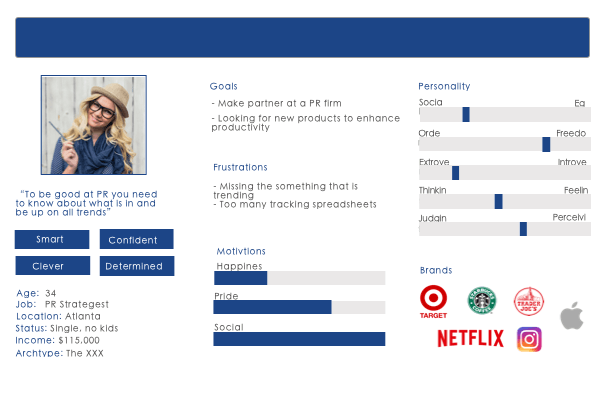A Guide to Creating Personas

A persona is a profile that represents your primary users. According to the Nielsen Norman Group, personas are fictional representations of a cluster of your target users who exhibit similar attitudes, goals, and behaviors in relation to your product. They’re human-like snapshots of relevant and meaningful commonalities among your customer groups that are based on user research. Personas should be a key part of your user research synthesis.
UX personas are more useful when paired with an empathy map since researchers can really get into the shoes of their users. It will also help the product team keep the user’s journey in mind.
Why you need a Persona

Personas will help you determine for who you are creating your product or service. This allows your team to navigate design and feature decisions to meet the needs, motivations, and desires of your core customer.
By creating a persona, you will be able to settle disputes amongst the product and design teams since you have a better way of understanding your primary customer’s needs and expectations.
Marketing Personas vs User Experience Personas

In this post, we’ll focus on UX personas, which are created to help product teams empathize with a group of real people. It gives you the
Marketing personas are based on market research from your existing customers, which is useful for segmenting and targeting.
Limit the Number of Personas
Although it’s tempting to create many UX personas you should limit the number of personas to one or two. This can be difficult because you may feel like your product users have so many behaviors and motivations so they should each be a different persona. However, a persona is a combination or aggregation of those behaviors and motivations, so one or two personas should represent the larger group.
It is important to note, that if you create too many personas, your team will lose focus on the most important parts of your core user group that the persona is meant to represent.
If you have 5 personas, your capacity to keep all of those personas at the front of your mind when making decisions is too difficult. Your team will have a hard time referencing, let alone remembering, those personas, on the day-to-day.
Focusing on one or two personas allows your team to develop empathy for them. After all, product teams know that empathy is the key to designing world-class products!

Do Your Research
In order to create accurate personas, your personas must be based on research. Research is used to understand the shared behavior and needs amongst your product users.
We suggest you speak to 5 users per product type. For example, If you identify that your business needs two personas you should speak to 5 users for each persona type, so 10 users total.
Ideally, you should conduct moderated research sessions. The benefit of moderated sessions are that you have a discussion guide to guide the conversation but you also have the ability to sidetrack and ask follow up questions to unearth relevant details.
If your business doesn’t have the time or the budget to conduct the proper research, you can always start with a persona that is based on assumptions, competitor analysis or internal stakeholder interviews. While this is a good start, fact-based personas require that you speak to your customer base.
Conducting Research for Personas

When speaking to participants during a moderated session, your questions will be different based on your product or service.
However, you should make sure to ask questions about the participant’s personal life.
- Where do you live?
- What do you do in your spare time?
- What are your favorite brands? This question is especially important, since understanding the brands your customer prefers can give you a real understanding of their personality and what motivates them.
Also, ask technical background and employment questions.
- How do you spend a typical weekday?
- What software & tools do you use while working?
- How many hours do you work in a typical day?
- What devices do you use at work?
- How do you manage your hectic schedule?
Lastly, ask professional questions about their needs and goals such as:
- What are your goals?
- How you plan on achieving your goals?
- What do you need to achieve those goals?
Often people think about their target demographic as something broad such as “females, who are freelance PR professionals”. However, that’s way too general. Instead, think about Jane who grabs coffee at her local independent coffee shop in Brooklyn before she rides the train to work while checking her emails.
From these questions, you will perform user research synthesis and analysis so you can aggregate your customer’s behaviors, beliefs and motivations to create personas.
Analyzing Results From Your Moderated Sessions

When synthesizing the results from the moderated interviews, you should look for overlap and patterns in personalities, characteristics or traits that the participants share.
For example, if you notice a couple of your participants mention they don’t trust companies to protect their data and have recently stopped using social media because they are increasingly concerned with their personal security. That is a good data point to add to your persona.
The goal of creating personas is to help the product and business teams focus on the wants and needs of their customers. If used correctly, personas can help the team settle design and feature conflicts. When making these decisions, the team is able to focus on the wants and needs of their primary persona rather than their own personal feelings towards the design decision at hand.
Components of a Persona
1. Select an image
When selecting the image, keep in mind that it should be a real person and someone that represents your target customer. Don’t use a celebrity or a cartoon. Instead, you want someone that represents the age, gender, ethnicity and personality of your persona.
2. Give your persona a name
You should give them a name because they are a representation of your primary user, so you should refer to them as a real person. A person has thoughts, feelings, and behaviors that you can empathize with while making design and feature decisions. Naming your persona is key since it adds a human element and creates a storyline narrative to aid in problem-solving.
3. Give your persona a short biography
Feel free to use personal and employment data points that were collected during your interviews.
4. Include a quote for your persona
Your quote can be a quick snapshot of their personality or something that is important to them. Again, the goal is to allow everyone on the team to empathize with the persona.
5. Include different brands that represent your persona
These brands allow you to add context to your persona and will act as your mood board. When you look back at your persona at a later date, you’ll lean on that quick snapshot and those brands can help trigger empathy for your persona. If your persona’s favorite brands are Trader Joe’s, Instagram and Lyft you’ll guide your product differently than if their preferred brands are Maserati, Louis Vuitton, and Whole Foods.
You can deduce a lot about the brands that your persona prefers. If your persona likes Trader Joe’s, you can assume they enjoy a friendly environment, with quality products and low prices.
Even though Trader Joe’s has nothing to do with a SaaS product for PR professionals. The PR product can embody the same attributes and expectations of Trader Joe’s.
6. Add beliefs and behaviors
These are things that are important to your persona. They are also things that your personas do on a daily basis. For example, they utilize Instagram and Twitter to keep up on the latest trends.
7. Outline your persona’s goals.
It is important to understand their aspirations since you want your product or service to help achieve those goals.
8. Understand their pain points
What things frustrate your persona? Do they hate doing busy work or routine tasks? Are they annoyed when speaking to customer service representatives? Once you understand their frustrations, you can solve for them and build better products that fit their needs.
9. Add personality or characteristics
This is pulled from the Myers Briggs personality test. While it’s a great touch, it’s not completely necessary.
10. Understand their motivations
It can be beneficial to show this in a more visual way, so you can easily see what drives your persona.
Once complete, post it all around your office. Try to make it as obvious as possible, so people are constantly referring to it.
Lastly, your personas should have an expiration of roughly one year. The world is constantly evolving – there are new technologies, organization processes, and customer expectations. It is important to keep your persona relevant in order to be useful and effective.
If you take anything away from this article, it should be that personas are a great way to empathize with your customers.
Download your free template here
General FAQs
What is a persona?
Personas are a fictional representation of your average user. They’re human like snapshots that enable you to keep the user in mind with every decision.
How do you create a persona?
Conduct moderated studies with your target audience. Ask participants questions about their habits, behaviors and beliefs. After the interviews, look for similarities and fill in a personas template.
Why do personas matter?
Personas allow you to make educated product and business decisions based on your typical customers preferences.
Start getting user feedback today


